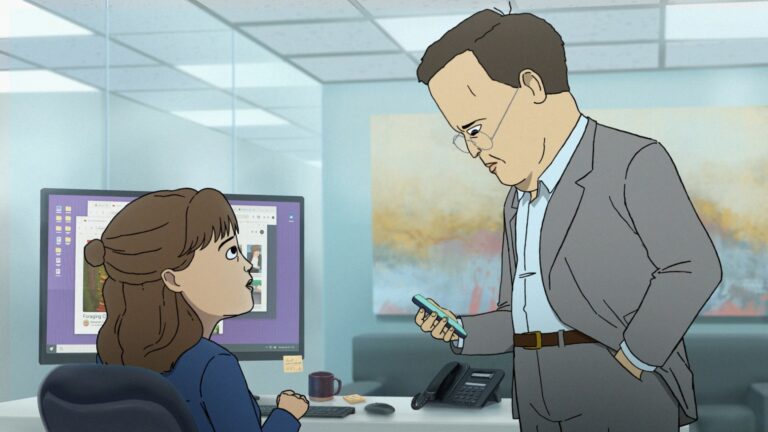There’s a weird kind of magic happening in the recording studios behind Common Side Effects. If you haven’t already fallen for the rapid-fire banter and legit friendship vibes between Marshall and Frances, you must be snoozing. These two sound like they’ve been swapping inside jokes and dissecting weird mushrooms for a decade — which is honestly wild, because the voice actors, Dave King and Emily Pendergast, are rarely even in the same room, let alone the same zip code.

Perfect Pairing: The Casting Quest
So, how did this animated odd couple become the talk of Adult Swim’s 2025 lineup? You’ve got to thank co-creator Steve Hely for his borderline-obsessive dedication to nailing the right voices. According to Hely (who happily overshared in interviews — cheers, Steve), they went through a marathon of auditions before even shortlisting King and Pendergast.
Let’s start with Dave King. He’s always been a renaissance man: writer, podcaster, sarcastic soul. But what really clinched it? Apparently, King’s voice has this natural, offbeat calm — like someone who spills coffee on himself but never loses his cool. That’s pure Marshall.
Then Emily Pendergast walks in, already beloved by the HBO crowd for her killer work on “Veep.” She brought this impossible combo: quick-witted, almost goofy timing, but with real vulnerability. Frances could easily become tropey or one-note, but Pendergast finds every weird corner in the dialogue and runs with it.
But here’s the kicker. Despite all this chemistry on air, King and Pendergast never step into the same studio booth. Ever.
Behind the Chemistry: More Than Just Good Voices
So, the next question pretty much writes itself — how do these two pull off sitcom-level chemistry while working thousands of miles apart? The answer: a downright ridiculous level of prep, plus some unsung heroes on the technical side.
- Both actors work out deep-dive backstories. We’re talking childhood traumas, favorite songs, fears — stuff never said out loud but always shaping the way they react.
- Each episode starts with a conference call or at least a giant inbox full of hyper-detailed notes from the showrunners, making sure King and Pendergast are always tuned to the same emotional frequency.
- The director, Cat Solen, sometimes feeds them little snippets from each other’s takes to play off. The goal: every comeback to land fresh, never canned.
What’s impressive is that neither actor phones it in. There’s no waiting on the other to bring the energy — they both show up in the booth like they’re about to win an Oscar, even though no one can see their sweatpants.
Wit in Action: How the Performances Land
Now, the heart of the show isn’t just that Marshall and Frances finish each other’s sentences or one-up each other’s jokes — it’s that every beat feels spontaneous and unfiltered. Sure, there’s a script, but the final product sounds like they’re riffing over brunch.
So, what’s their secret sauce? A few time-honored voice acting tricks help, according to the folks at worldvoiceovers.com:
- Breath control: King and Pendergast both use breathing strategies — think pro musicians holding long, precise notes — to punch up their punchlines or let a moment sit in the air.
- Articulation and pacing: Neither actor rushes or mumbles. They play with timing, stretching certain pauses for weight or snappiness.
- Emotional commitment: Every line comes from a lived-in place. Even a throwaway joke about genetically engineered algae sounds loaded with subtext because both actors buy into the world, totally.
The Unsung Sound Geniuses
From there, things get even more technical. If you peel back the audio layers, you’ll discover sound engineers doing straight-up wizardry. They cross-stitch each actor’s solo takes into seamless, overlapping banter — editing for rhythm, warmth, and even the echo on a “yeah, right.” (Yes, that’s a thing.)
The process looks like this:
- Engineers balance audio so the voices share the same “room” feel, eliminating that dreaded ping-pong effect you sometimes hear in other animated shows.
- Timing tweaks avoid awkward gaps. Frances’s snort-laugh lands right as Marshall’s last syllable drops.
- Ambient background noise, coughs, and the sound of flipping notebook pages all get slotted in to glue the tracks together.
What the Fans Are Saying
So, how does all of this fancy voicework land with real viewers? If you dive into Twitter and Reddit, it’s nonstop praise for Marshall and Frances’s rapport. People are out here analyzing every one-liner and deadpan sigh, convinced the actors must rehearse for days together. Spoiler: They don’t.
- Reddit user “grapeleaves” wrote, “Can’t believe these two don’t record together — feels like they’re riffing off each other in real time.”
- Tweets fly during airings, with viewers gushing about “buddy comedy energy” and “binge-worthy chemistry.”
Critics are noticing too. Several reviewers have pointed out how rare it is for adult animation duos to feel this alive. Usually, you get either too much improv or ultra-polished lines that lose their spark. Here, the balance just works. One critic from Vulture even called Frances and Marshall’s friendship the “emotional core” of the show.
Voice Acting’s New School: Why This Approach Rocks
Now, let’s zoom out for a sec. Animation has always depended on outsize voice talent, but Common Side Effects takes things next-level. The show’s producers lean into the tech, using cloud recording and real-time digital mixing instead of old-school group sessions. That means King and Pendergast get flexibility, but it also means nobody can coast — they’ve got to hit every beat cold.
Still, these folks find ways to surprise each other. On occasion, directors send over surprise snippets, outtakes, or extra lines for the other actor to react to. This keeps their deliveries sharp and a bit unpredictable — which, let’s face it, is the heart of their weird science friendship.
It’s not all smooth sailing, though. Recording solo can get lonely. King poked fun in interviews, saying he sometimes imagined an actual Frances “sitting on his old futon, peeking at his notes.” Pendergast, meanwhile, confessed she keeps a Marshall-esque coffee mug on her mic stand for moral support. If it works, it works.
From Episode One to Now: Why the Duo’s Still Hitting Home
If you tune in week to week, you’ve probably noticed their chemistry hasn’t faded. In fact, it somehow keeps getting better. Probably helps that the writers know how to play their strengths and toss in ever-weirder challenges (and edible fungi).
- As the plot twists, King and Pendergast dig deeper. Episodes touch on friendship, heartbreak, and bad science jokes, all in equal measure.
- Frances’s comedic reactions counterbalance Marshall’s much-drier delivery. That constant push-and-pull never gets old.
You can practically feel the trust between them. Everything from a mutual groan to an unexpectedly touching pep talk carries more heft because these two know exactly when to push and when to pull back.
One Last Dose of Chemistry
So, what’s the verdict? Marshall and Frances don’t just work because of clever scripts or fancy editing (though, let’s be real, those help plenty). Their magic lies in relentless prep, wickedly smart direction, and two world-class actors who never hide behind a microphone. If you think voice chemistry can only come from face-to-face improv, Common Side Effects just proved you wrong — and probably made you believe in the impossible. If that isn’t science, what is?
And the next time you hear Frances roast Marshall for his questionable mushroom facts, remember: sometimes the best experiments happen when no one’s in the lab together.




